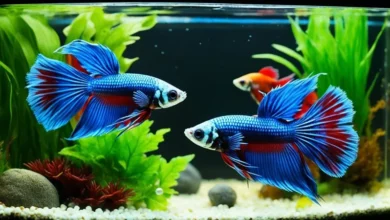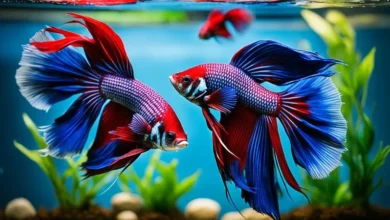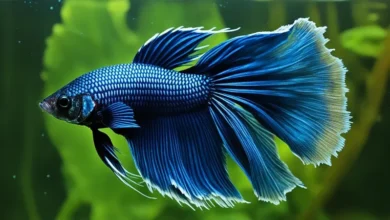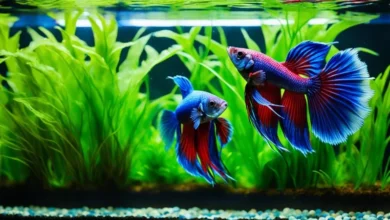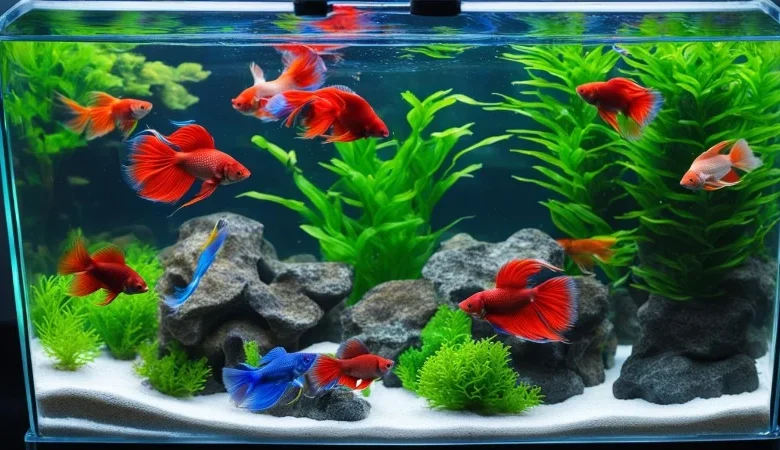
If you’re a fan of aquariums and a lover of vibrant, stunning fish, then you likely have a special place in your heart for betta fish. Known for their gorgeous colors and elegant fins, bettas are a popular choice among fish enthusiasts. However, breeding betta fish requires a precise care routine to ensure the health and success of your fish.
In this article, we will delve into the daily tasks required for a thriving breeding betta fish care routine. Whether you’re an experienced breeder or just starting, these tasks will help you maintain an optimal environment for your bettas and ensure their overall well-being. So let’s dive in and explore the world of breeding betta fish care routine together!
Equipment List for Breeding Betta Fish
When it comes to breeding betta fish, having the right equipment and supplies is crucial for a successful outcome. Here is a comprehensive list of essential items you will need:
- Transparent Divider or Large Glass Jar: You will need this to separate the male and female bettas until the nest is complete.
- Gentle Filtration System: To maintain water quality in the breeding tank, consider using a sponge filter or platform filter.
- Heater: It is important to maintain a stable water temperature for optimal breeding conditions. A heater will help you achieve this.
- Floating Plants or Nest Anchors: Provide plenty of floating plants or other floating objects for the male betta to anchor his nest.
- Aquarium Net: You will need this to safely remove the male and female bettas during the breeding process.
- Small Live Foods: Once the fry become free-swimming, you will need a supply of small live foods to feed them.
Having these equipment and supplies ready will ensure that your breeding tank is properly set up and equipped to support the successful breeding of your betta fish.
Setting Up the Breeding Tank for Betta Fish
Setting up a proper breeding tank is crucial for the success of betta fish breeding. To create the ideal environment for breeding, it is recommended to use a 10-gallon aquarium as the breeding tank. This tank size provides enough space for the bettas to swim and is easier to maintain in terms of water quality.
The breeding tank should have gentle filtration to ensure proper water circulation without causing excessive water movement that could harm the fragile fry. A sponge filter or a platform filter can be used for this purpose.
It is important to maintain specific water conditions in the breeding tank. The water should be soft and mildly acidic, with a pH level between 6.5 and 7.5. Keeping the temperature of the water at 80-86°F (27-30°C) is essential for the bettas’ breeding behavior and fry development.
When setting up the breeding tank, it is recommended to remove any substrate. This helps to facilitate the breeding process and prevents the fry from getting trapped or injured. The absence of substrate also makes it easier to maintain cleanliness and monitor the health of the bettas and fry.
Decorations such as floating plants and nest anchors are essential in the breeding tank for the male betta’s comfort. Floating plants serve as a natural environment for the female betta to rest near the surface and build a bubble nest. Providing suitable nest anchors, such as styrofoam or artificial plants, helps to ensure the stability of the nest.
Creating the right breeding tank setup is crucial for the successful breeding of betta fish. By following these guidelines, you can provide the bettas with an optimal environment for breeding and raising their fry.
Selecting the Right Breeding Stock
When embarking on the journey of betta fish breeding, it is crucial to select the right breeding stock to ensure successful outcomes. Both the male and female bettas should possess strong physical and behavioral characteristics that indicate their suitability as breeding candidates.
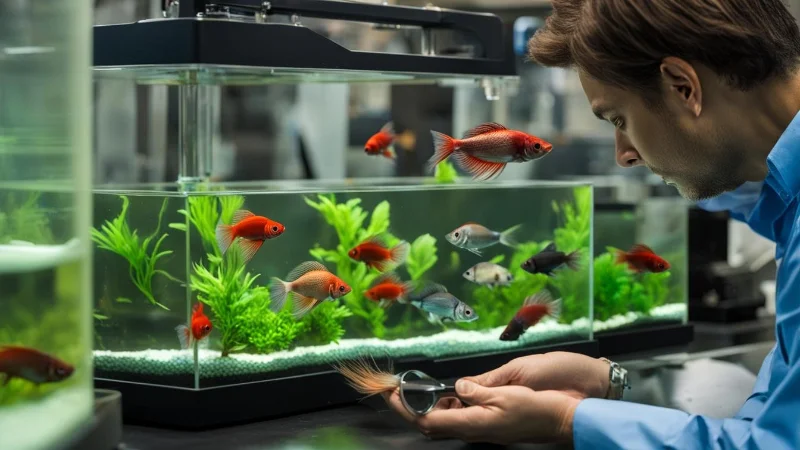
For the male betta, pay attention to factors such as healthy finnage, active behavior, good coloration, a laid-back personality, and a healthy appetite. These traits indicate the male’s overall vitality and breeding potential.
Similarly, female bettas should exhibit similar characteristics, including good health, strong body and fins, bright coloration, and an active behavior. These traits signify the female’s reproductive fitness and ability to produce healthy fry.
It is essential to condition the breeding pair for two to four weeks before attempting to breed them. During this period, provide them with a high-protein diet rich in live foods, which mimics their natural feeding patterns and prepares them for reproduction.
By carefully selecting the right breeding stock and providing them with optimal conditions, you can increase the chances of successful betta fish breeding and raise healthy offspring.
The Breeding Process: Step-by-Step Guide
The breeding process for betta fish involves several steps that need to be followed carefully. To ensure successful breeding, it is important to understand the process and provide the bettas with a suitable environment. Here is a step-by-step guide:
1. Introduce the male and female bettas to the breeding tank
Start by introducing the male and female bettas to the breeding tank. This can be done either by using a transparent divider or by keeping them in separate containers within the tank. This allows them to become familiar with each other’s presence without direct contact.
2. Complete the nest
Once the bettas show signs of readiness, such as the male building a bubble nest, it is time to complete the nest. Provide the male with plenty of floating plants or other objects that can serve as anchors for the nest.
3. Release the female
When the nest is complete and both bettas are displaying signs of readiness, release the female into the breeding tank. Observe their behavior closely during this time to ensure they are compatible and displaying courtship behavior.
4. Observe the spawning process
During the spawning process, the male will try to entice the female to spawn by performing various courtship displays. It is important to closely monitor their behavior during this time and intervene if any signs of aggression are observed.
5. Remove the female
Once spawning is complete, it is crucial to remove the female from the breeding tank to prevent any potential aggression from the male. This can be done using a net or by gently scooping her out with a container.
6. Caring for the fry
After a couple of days, the fry will hatch from the eggs. It is important to provide them with appropriate food and maintain water quality during this critical stage of their development.
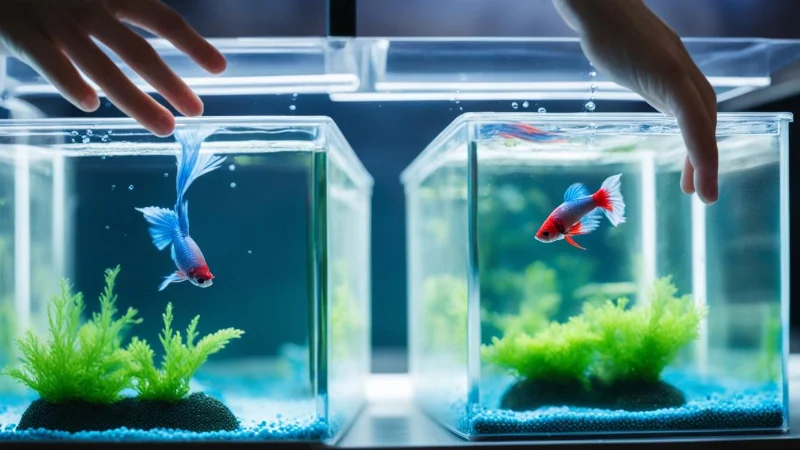
The step-by-step guide outlined above can help you navigate the breeding process and increase your chances of successfully breeding betta fish. By following these steps and providing optimal care, you can enjoy the rewarding experience of breeding bettas and watching their fry grow.
Caring for Betta Fry: Feeding and Water Quality
Taking care of betta fry is an essential aspect of the Breeding Betta Fish Care Routine. Providing them with the right food and maintaining optimal water quality is crucial for their healthy development.
Betta fry primarily rely on live foods to meet their nutritional needs. Some suitable options include infusoria, brine shrimp nauplii, microworms, vinegar eels, and small organisms like daphnia and cyclops. These live foods provide the necessary nutrients and promote the growth and vigor of the fry. Additionally, blended live foods such as bloodworms and tubifex can be given to supplement their diet.
It is crucial to culture or obtain these live foods to ensure the proper growth and development of the fry. By providing a variety of live foods, you can mimic their natural feeding patterns and ensure they receive the necessary nutrition for optimal health.
In addition to proper feeding, maintaining good water quality is vital for the health and survival of betta fry. Regular water changes should be carried out to remove accumulated waste and maintain optimal parameters. It is recommende
Conclusion
Breeding betta fish requires careful planning, appropriate equipment, and a consistent care routine to ensure a successful breeding process. From setting up the breeding tank to selecting the right breeding stock, each step plays a crucial role in creating an ideal environment for the bettas to breed and raise their fry.
By paying attention to detail and providing the bettas with suitable conditions, such as a properly conditioned breeding pair, a well-maintained tank, and a nutritious diet, you can promote healthy breeding and the growth of the fry. Regular monitoring of water quality parameters and regular feeding of live foods are essential for the well-being and survival of the fry.
With a good breeding betta fish care routine in place, your bettas can thrive and you can experience the rewarding and fulfilling journey of successfully breeding these beautiful fish. Remember to remain attentive and proactive throughout the process, as each day brings new tasks and responsibilities for the care and growth of your betta fish.
